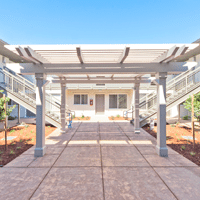In one of its most ambitious rehab projects to date, the Housing Authority of the County of Santa Clara (HACSC) chose to take a step firmly forward and incorporate sustainable features into more than 500 units of affordable housing. “We saw an opportunity to promote environmental sustainability within these properties—both to the benefit of tenants and the authority—and decided to go with it,” says HACSC executive director Alex Sanchez. The initiative was made possible through $95 million in private-sector equity funding and commercial debt.

The HACSC incorporated sustainable features into a 500-unit renovation project. Photos: Peter S. Carter Photography
Now in its 43rd year of service, HACSC provides rental subsidies and develops affordable housing for low-income families, senior citizens, and persons with disabilities living in Santa Clara County, California. The organization serves 20,000 households with 50,000 individuals housed by the authority on a monthly basis, and its recent renovation has similarly broad impacts. The organization prioritized a number of energy-saving and environmentally friendly elements, with a particular focus on regional adaptations. Landscape architect Dillon Design Associates, for instance, removed grass from the rehabilitated properties and replaced it with native California greenery. “Lawn is one of the most inefficient types of plant material for landscaping,” says Michael Dillon, a principal at Dillon Design. “It requires large amounts of water, fertilizer, and maintenance. Throughout the HACSC renovation projects, significant areas of lawn were replaced with low-water-using and low-maintenance plant material.”
Energy cost savings also figured prominently. The installation of Mitsubishi HVAC systems resulted in less noise, greater efficiency, and more environmentally friendly heating and air-conditioning. Installing dual-pane, energy-efficient windows has enabled apartments to keep cooler in the summer and warmer in the winter. Within each renovated unit, use of low-VOC paint and carpeting generated improved air quality. Utilization of Energy Star appliances, including washers and dryers, has prompted lower energy expenses. Similarly, use of motion-sensing and photovoltaic-powered lights, as well as LED parking-stall lighting, promoted significant reductions in electrical costs.
Although the cost savings and environmental benefits of these green upgrades are apparent, there were challenges. “During the construction, we strived to keep tenants in place whenever feasible,” says Vanessa Cooper, HACSC’s director of real estate services. “Frequently, however, this meant temporarily moving individuals and families from one apartment to another.” There also were structural considerations. Orlando Reyes-Rodas, HACSC’s real estate project manager, says, “It was sometimes necessary to redirect load-bearing beams or modify joists to accommodate the new HVAC system.”
Perhaps the best measure of the rehabilitation project’s green success can be found with tenants’ positive reactions. “We’ve received favorable comments about additions like the tankless water heaters, which, because of their small size, allow for more living space in the apartments,” Cooper says. “It’s always gratifying to hear such positive reviews. It reminds us of how important and environmentally worthwhile this project has been.”

